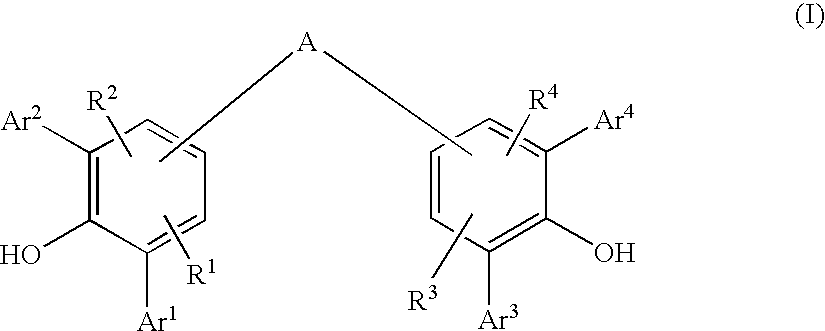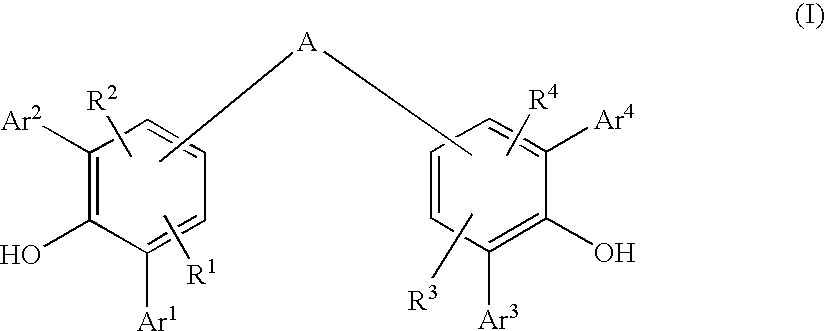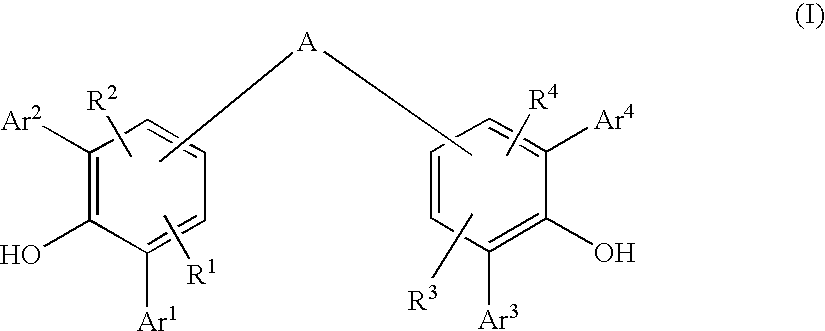Diarylphenoxy Aluminum Compounds
a technology of diarylphenoxyaluminum and aluminum, applied in the field of diarylphenoxyaluminum compounds, can solve the problems of inability to recover the catalyst complex used, high cost of catalyst complexes used, and inability to manufacture in a complex manner
- Summary
- Abstract
- Description
- Claims
- Application Information
AI Technical Summary
Benefits of technology
Problems solved by technology
Method used
Image
Examples
example 1
Cyclization of Citronella to Isopulegol in the Presence of a Catalyst Produced From the Ligand Ia1-1 and in the Presence of Acetic Anhydride
[0162]
[0163]A heat-dried flask was charged with 1.05 mmol of the ligand Ia1-1 and 10 ml of anhydrous toluene. At room temperature, 350 μl (0.66 mmol, 1 mol %) of a 25% strength solution of triethylaluminum in toluene were added to the clear solution. The solution was stirred for 1 h at 25° C. After a few minutes, a gel-like suspension of the catalyst was obtained. The catalyst suspension was cooled to 0° C., and a mixture of 10.15 g (65.8 mmol) of citronellal precooled to 0° C. and 1% by weight (based on citronellal) of acetic anhydride was added over a period of 6 h. The reaction mixture was stirred, and samples were taken at regular intervals and hydrolyzed with 8% strength NaOH. During this, the aluminum present precipitated out as hydroxide and a suspension was firstly obtained. After some time, two clear phases formed. The organic phase was...
example 2
Cyclization Using the Ligand Ia1-4 (With Acetic Anhydride)
[0165]
[0166]Example 1 was repeated using the ligand Ia1-4 (on a larger scale) under otherwise unchanged conditions. The results are shown in table 5.
TABLE 5TimeCitronellalCitronellalCitronellalIsopulegolIsopulegolCitronellolCitronellolin hadded in gin % by wt.in gin % by wt.in gin % by wt.in g216.9226.544.4963.0010.661.630.28325.3824.236.1565.8716.721.530.39433.8319.146.4872.5424.541.400.47542.2917.667.4774.8031.631.200.51650.7519.7310.0173.2237.161.040.53750.7511.976.0780.5140.861.020.522450.751.240.6390.1145.730.960.49
[0167]After a reaction time of 24 h, the conversion of citronellal was complete with a selectivity of 90% with regard to all isopulegol isomers. The diastereoselectivity (neo isopulegol:isopulegol:neoiso-isopulegol:iso-isopulegol) was 0.6:99.0:0.3:0.1.
example 3
Cyclization Using the Ligand Ia2-1 (Without Additives)
[0168]
[0169]A heat-dried flask was charged with 640 mg (1.0 mmol) of the ligand Ia2-1 and 10 ml of anhydrous toluene. At room temperature, 350 μl (0.65 mmol, 1 mol % with regard to citronellal) of a 0.66 M solution of triethylaluminum in toluene were added to the clear solution. The solution was stirred for 1 h at 25° C., giving a gel-like suspension of the catalyst after a few minutes. The catalyst suspension was cooled to 0° C., and 10.2 g (65.8 mmol) of −15° C.-cold citronellal were added over a period of 6 h. The reaction mixture was stirred for a further 18 h at 0° C., and samples were taken at regular intervals and hydrolyzed with 8% strength NaOH. During this, the aluminum present precipitated out as hydroxide and a suspension was firstly obtained. After some time, two clear phases formed. The organic phase was analyzed by gas chromatography, The results are shown in table 6:
TABLE 6Ester*inCitronellalCitronellalIsopulegolC...
PUM
| Property | Measurement | Unit |
|---|---|---|
| molar ratio | aaaaa | aaaaa |
| optically active | aaaaa | aaaaa |
| boiling | aaaaa | aaaaa |
Abstract
Description
Claims
Application Information
 Login to View More
Login to View More - R&D
- Intellectual Property
- Life Sciences
- Materials
- Tech Scout
- Unparalleled Data Quality
- Higher Quality Content
- 60% Fewer Hallucinations
Browse by: Latest US Patents, China's latest patents, Technical Efficacy Thesaurus, Application Domain, Technology Topic, Popular Technical Reports.
© 2025 PatSnap. All rights reserved.Legal|Privacy policy|Modern Slavery Act Transparency Statement|Sitemap|About US| Contact US: help@patsnap.com



